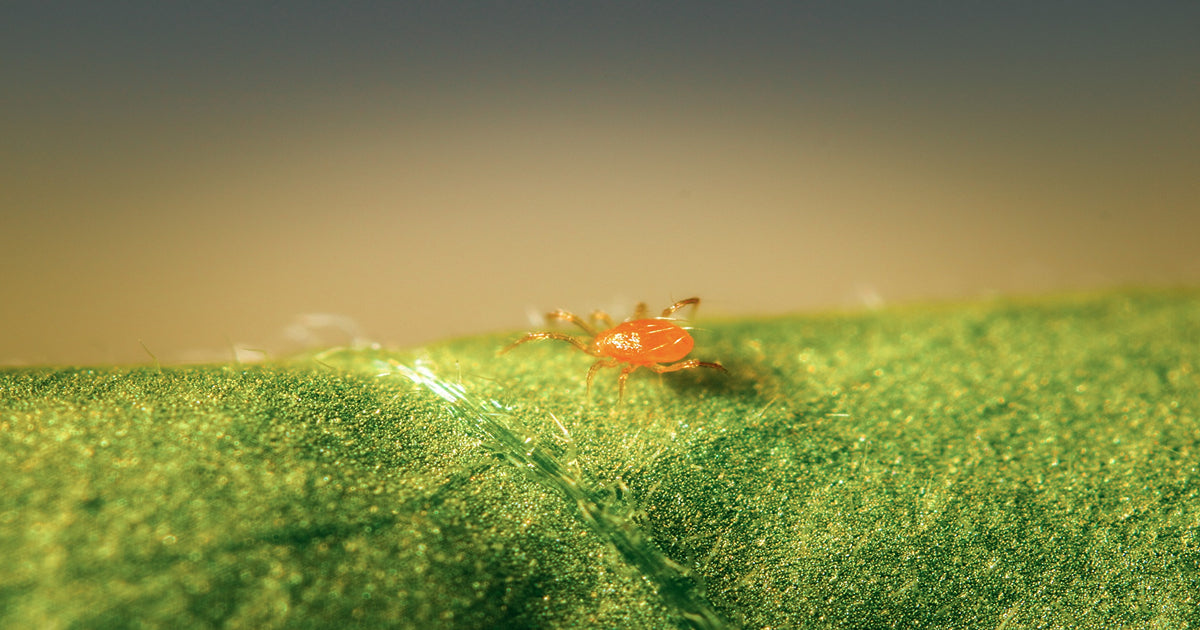
Dragonfli's Natural Predator Guide
There are now lots of different predatory mites used in the biological control of Spider Mites and Thrips and it can be difficult to know which is the right control to opt for. At Dragonfli we’ve come up with a guide to help you make the right choice.
The best predators for the Two Spotted Spider Mite (commonly known as the Red Spider Mite)

The Two Spotted Spider Mite (Tetranychus urticae).
There are three predatory mites available for the biological control of Spider Mite. A recent study conducted by Koppert Biological Systems compared the reproduction speed of each predator and how quickly they controlled Spider Mite infestations.
The study found that the fastest to reproduce and control Spider Mite was the Phytoseiulus persimilis. This is the predator we use in our Spider Mite Curative System. Choose this predatory mite if you are already suffering from a clear Spider Mite infestation and temperatures are above 20℃. The Phytoseiulus provides a faster control of Spider Mites and will attack Spider Mite in their webs and webbing, unlike the Amblyseius andersoni which will not enter such areas of infestation. This makes the andersoni a bad choice of Spider Mite predator if you already have spider mite present in high numbers.

Phytoseiulus persimilis predators are the fastest control for Spider Mite infestations.
The next fastest establishing predator found in the study was the Amblyseius californicus (also named Neoseiulus californicus). This is the predator we use in our Spider Mite Preventative System.
This predator establishes quickly on the plant and will also go into Spider Mite webbing. It can be supplied in slow release sachets, which makes it ideal as a preventative treatment for Spider Mite. Amblyseius californicus will also feed on other mites and pollen, enabling it to live on plants when no spider mite present. Phytoseiulus persmilis is not yet available in slow release sachets and so must only be released when Spider Mites are present. The two predators can be used successfully together.

Amblyseius californicus predators can be released slowly from our sachets as an ideal protection against Spider Mite infestations.
One restriction in the application of Amblyseius californicus is that it is not yet permitted for outside use. For Spider Mite control outside in the summer, when it is warm, use Phytoseiulus persimilis. For preventative treatments outside, when it is cooler, use Amblyseius andersoni .
The best predators for Thrips

A Thrip from the Thrips tabaci species.
The predatory mites available to control Thrip will only consume the larvae of the thrip, unlike certain Spider Mite predators which essentially eat the entire Spider Mite life cycle. For this reason it is important to apply Thrip predatory mites to plants as early as possible so that they have a chance to break the Thrip life cycle. In the same way as the Spider Mite predators, there are now a few Thrip predators to choose from.
The first predator used for Thrip control in greenhouses was the Amblyseius cucumeris. It is still widely applied as a preventative and curative control of Thrips and is normally the cheapestoption. It is active from 15℃ and consumes the first, very small, Thrip larvae, so you do need a good population of predators present on the plant. For preventative applications opt for our slow release sachets which will release predators for approximately 4 weeks. To build up and spread a population quickly over leaves opt for a shaker bottle application and then follow this up with sachet introductions.

An Amblyseius cucumeris predatory mite consuming a Thrip larvae. The cucumeris mite will only consume these small larval stages of the Thrip.
In recent years another predatory mite has been added to the armoury against Thrips in the form of Amblyseius swirskii. This predatory mite also eats Thrip larvae but is capable of eating larger bodied larvae, so is capable of consuming more Thrip larvae overall. The swirskii will also feed on Whitefly eggs.It requires temperatures of 20℃ plus to be active.
A good application strategy can be to start Thrip control with Amblyseius cucumeris, especially if temperatures are lower, and then switch to Amblyseius swirskii once temperatures are over 20℃. Amblyseius swirskii are also available in foil sachets which provide extra release life, whereby predators are produced for up to six weeks.

Two Amblyseius swirskii predators sharing a Thrip larvae. The swirskii mite will consume larger Thrip larvae than the cucumeris and will also consume Whitefly eggs.
Choosing the right predator is very important to get the best results from your predatory mites and we hope this guide has helped you to make the right choice.
Comments (4 Responses)
Mav
Thank for the advice but where can l purchase the PHYTOSEIULUS please?
Julian Ives
Hi Miranda, thanks for getting in touch.
We have a fantastic new solution for the Carpet / Clothes Moth larvae bugs that feast on clothes, carpets and fabrics. Our ‘Moth Egg Killer Sachets’ are full of tiny Trichogramma parasitic wasps that are released in waves to parasitise the Clothes Moth eggs. This will prevent the harmful larvae from developing and contribute to reducing the overall Clothes Moth population.
The sachets simply need to be placed flat in the relevant area of infestation, or placed wherever you’d like to protect your clothes, carpets and fabrics. There is no need to open the sachets as an emergence hole is already supplied and the wasps will gradually emerge to do their job and protect your belongings! You can find this product here:
https://www.dragonfli.co.uk/collections/clothes-moths/products/clothes-moth-egg-sachets
We have select programmes of the sachets available whereby you can choose to receive a specified amount of sachets per month to ensure consistent control without the need of reordering, you can find this here:
https://www.dragonfli.co.uk/collections/clothes-moths/products/moth-egg-killer-sachet-programmes-trichogramma-parasitic-wasps
We also sell a ‘Clothes Moth Pheromone Trap’. This can be used in conjunction with the sachets for maximum control (so long as they are not deployed too closely together as we wouldn’t want the helpful Trichogramma getting stuck in the traps!). The trap works via a specialist Clothes Moth pheromone which lures the male Clothes Moths into the trap where they will become stuck on the glue inside. This is great for reducing the male Clothes Moth population and preventing the moths from reproducing, as well as providing you with a helpful pest monitoring device where you can evaluate the severity of your infestations. You can find this product here:
https://www.dragonfli.co.uk/collections/clothes-moths/products/clothes-moth-trap
We also sell discounted bundles of the traps and sachets which you can find here:
https://www.dragonfli.co.uk/collections/clothes-moths/products/clothes-moth-killer-mixed-bundle-2-trichogramma-cards-2-pheromone-traps
https://www.dragonfli.co.uk/collections/clothes-moths/products/clothes-moth-multiple-trap-lures-kit
Hope this all helps but if you both need any further advice feel free to get in touch via email at sales@dragonfli.co.uk, via social media, or by giving us a call on 01376 563322, and we’d be happy to assist.
Kind regards, Julian Ives [Director, Dragonfli]
Miranda thwaites
What would you recommend for carpet mites and bugs attacking clothes?





27 June, 2024
Julian Ives
Hi Mav,
Thanks for reading.
You can find our Phytoseiulus pesimilis by following the link below:
https://dragonfli.co.uk/collections/spider-mite/products/spider-mite-killer-phytoseiulus-persimilis
Alternatively, click ‘Spider Mite’ on the ‘Insect Pests’ drop down menu and it will take you to a landing page with our full range of natural Spider Mite controls.
Kind regards, Julian Ives [Director, Dragonfli]